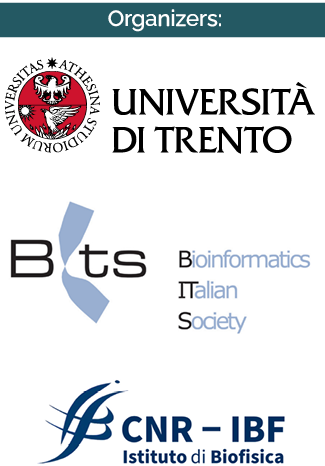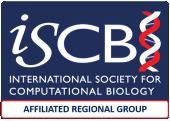To prepare humans for future exploration missions far from Earth, Space Biology research aims to understand how spaceflight affects living systems in environments such as the International Space Station (ISS). How do animals, plants and microbes adjust metabolism, growth, development or stress response when living in space? How do organisms repair cellular damage and protect themselves from infection and disease in microgravity while being exposed to space radiation? This workshop welcomes contributions on the topic of computational approaches applied to space biology.
12 June 2024, 9:00-12:15, Blue Room, Ecomomics Department, University of Trento
The preliminary program of the workshop is available at the BITS2024 conference program page.
Chair: Gabriella Viero, CNR - Institute of Biophysics, Italy
- 09:00-09:05 Workshop opening Paolo Macchi (University of Trento)
- 09:05-09:30 Space Science and Technology: from Planetary Exploration to Earth Observation. Lorenzo Bruzzone (University of Trento)
- 09:30-10:00 Space Exploration, status and perspectives Roberto Battiston (University of Trento)
- 10:00-10:30 Coffee break
- 10:30-11:15 Signatures of muscle disuse in spaceflight and bed rest revealed by single muscle fiber proteomics Marta Murgia (University of Padova and Max-Planck-Institute of Biochemistry)
- 11:15-11:45 The ZePrion Experiment: Crystallizing Protein Folding Intermediates on the International Space Station Emiliano Biasini (University of Trento)
- 11:45-12:15 Geologically empowered origin of life Silvia Holler (University of Trento)
Invited Speakers
Lorenzo Bruzzone (Department of Information Engineering and Computer Science, University of Trento).
Talk title: Space Science and Technology: from Planetary Exploration to Earth Observation.
Roberto Battiston (Department of Phisics, University of Trento). Roberto Battiston. Former President of the Italian Space Agency (ASI). During 40 years he has worked in international collaborations in the field of experimental physics on ground and in space experiments: Strong interactions, Electroweak interaction physics, Search for antimatter and dark matter in Cosmic Rays. Author of more than 460 papers published on international scientific journals. Hall of Fame of IAF (2019), International Science and Technology Cooperation Award- China(2019)
Talk title: Space Exploration, status and perspectives.
Emiliano Biasini (Department CIBIO, University of Trento). Dr. Biasini is an associate professor of biochemistry at the University of Trento. He has dedicated his entire career to studying prions and prion diseases. In 2017, through a collaboration with theoretical physicist Pietro Faccioli, he co-developed an innovative drug discovery technology named Pharmacological Protein Inactivation by Folding Intermediate Targeting (PPI-FIT) and founded the startup company Sibylla Biotech. More recently, he was involved in an international collaboration to test the PPI-FIT paradigm on the International Space Station.
Talk title: The ZePrion Experiment: Crystallizing Protein Folding Intermediates on the International Space Station.
Abstract: Targeting non-native protein conformations is among the most promising directions in contemporary drug discovery. We have developed a novel drug discovery paradigm called PPI-FIT, based on suppressing the expression of disease-relevant factors by targeting alternative protein conformations appearing along the folding pathways. This approach led to the discovery of a small molecule capable of selectively reducing the cellular levels of the human prion protein (PrP), which is involved in several fatal incurable neurodegenerative diseases. A crucial piece of information required in the hit-to-lead optimization of a drug candidate is the atomic resolution of its binding architecture. In conventional drug discovery, this information could be obtained by X-ray crystallography or NMR. Unfortunately, these techniques are hardly applicable to unstable protein conformers. Previous studies have highlighted the advantage of performing protein crystallization in microgravity conditions. We have capitalized on this concept to design a space-based technology to achieve the crystallization of protein non-native conformers. Our experimental setup was tested for the first time in August 2023 in a pioneering space mission named ZePrion-1. Current research aims to capitalize on the preliminary results generated by this first mission to develop the technology further, leading to a stable, scalable, and versatile protocol for crystallizing non-native protein conformers in microgravity conditions.
Marta Murgia ( Department of Biomedical Sciences, University of Padova and Max-Planck-Institute of Biochemistry, Germany). Marta Murgia works at the Dept. of Biomedical Sciences, University of Padova and at the Max-Planck-Institute of Biochemistry, Germany. She applies mass spectrometry-based proteomics to single skeletal muscle fibers and is interested in every angle of skeletal muscle physiology and pathology. Her interest for single cells originates from her PhD under the supervision of late Professor Tullio Pozzan. This led to understanding skeletal muscle fiber diversity and plasticity as a postdoc in the laboratory of Stefano Schiaffino at University of Padova. She is focusing on the proteomics of muscle atrophy and disuse, including the intriguing paradox of atrophy despite physical activity in astronauts.
Talk title: Signatures of muscle disuse in spaceflight and bed rest revealed by single muscle fiber proteomics.
Abstract: Skeletal muscle, which makes up around 40% of human body mass, undergoes extensive structural remodeling during space missions, resulting in atrophy and loss of force. Skeletal muscle deconditioning can only be partially attenuated by exercise countermeasures onboard. We applied mass spectrometry-based proteomics to the analysis of muscle biopsies of two astronauts who spent six months on the International Space Station (ISS), performing very different levels of onboard physical activity. Our comparative analysis of the astronauts’ muscle biopsies pre- and post-mission quantified over 7000 proteins, reaching 70% quantification of mitochondrial proteins. In agreement with recent reports, we measured in both astronauts a dramatic decrease in mitochondrial protein intensity during six months on the ISS. No comparable mitochondrial remodeling could be measured in ground-based models such as bed rest. My talk will explore the hypothesis that ionizing radiation and other sources of oxidative stress onboard, but not inactivity per se, may cause direct damage to skeletal muscle mitochondria in space. This would explain the limited efficacy of exercise countermeasures. I will discuss how onboard exercise may act indirectly, through the activation of an anti-oxidant response, to preserve muscle mass and function.
Silvia Holler (Department CIBIO, University of Trento). Silvia Holler is a postdoctoral researcher in the Cellular, Computational and Integrative Biology Department of the University of Trento. She obtained her PhD degree at the University of Trento in 2019. Her expertise include: geochemical analysis of origin of life, nanoparticles functionalization, and artificial protocells functionalization. Her research has huge potential for medical and industry applications, and her artificial cells constitute a dynamic, configurable set of microscopic systems that could be used to discover how life originated on earth and how it could be transposed to other planets.
Talk title: Geologically empowered origin of life.
Abstract: Alkaline hydrothermal vents are one of the potential locations for the origin of life on Earth and beyond. They possess critical attributes like temperature gradients, redox potential variations, pH levels and networks of pores that could have been crucial for life to arise. We examined chemical gardens, used as experimental proxy for hydrothermal vents, and integrated them with organic molecules. When organic molecules interact with these structures, it results in diverse three-dimensional arrangements at both macroscopic and microscopic scales. We analysed vesicle formation in presence of these new 3D arrangements. Neither chemical gardens nor organic molecules alone induce vesicle formation, but chemical gardens created in presence of organic molecules support vesicle formation. These findings, integrating biochemistry, astrobiology and geology, propose that the interplay between fatty alcohols and inorganic mineral structures might have played a crucial role in the emergence of life on earth and other planets.
Submission
Submission to the workshop is enabled via the BITS2024 conference submission form. Please, choose Session " Cosmic codes: Bridging Space Explorations and Bioinformatics (Workshop)".
The deadline and notification dates are the same as the key dates of the abstract submission to the main conference.



